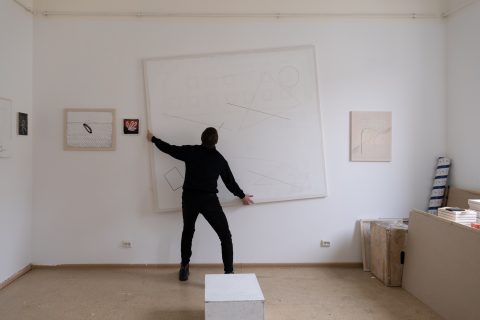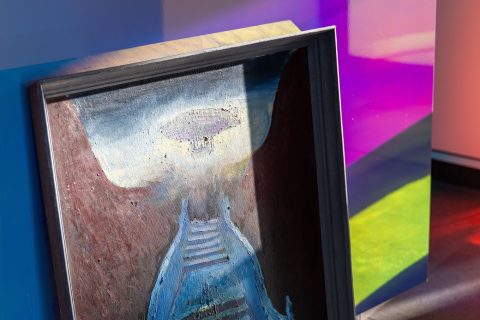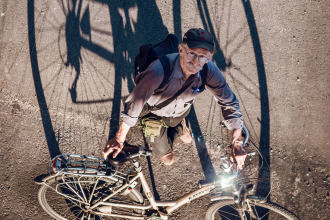Perhaps each of us creates a different image of our city in our minds. Walking down the streets we see the same buildings, plants, and roads, but we remember them differently. In addition, not only our memories are constantly changing but also the urban landscape. Perhaps it is the reason why so many are fascinated by old photographs in which we can get to know a different, non-existent city. It is also interesting to observe how the city – in this case Kaunas – was seen and depicted by artists in different periods.

The first stop is Vienybės Square which has recently changed its image. After the reconstruction, the Estonian artist Peeter Krosmann, who has been living in Kaunas for now, managed to capture it on canvas. The abstract forms of the new facades of the square and Christ’s Resurrection Church together with a bright blue sky in his painting White (2020) transports us to last summer. Although today Vienybės Square welcomes the passersby with grayer winter tones, it is not difficult to trace Krosmann’s stylization in the actual shapes of buildings. Meanwhile, to discover the location of the second picture of this route, you must use not only historical photographs, but also some imagination.
Here, we will not find the small single-story wooden houses, as the one depicted in the right corner of Mstislavas Dobužinskis’ painting Kaunas. The Houses of Daukanto Street (1931). Most likely, the houses captured in the composition stood on the eastern side of Vienybės Square, instead of the buildings that we now see in P. Krosmann’s work. So, it can be easier to imagine what this space looked like during the interwar period with your eyes closed than looking at its current image.

It will be easy to find examples of authentic interwar architecture by climbing the stairs to V. Putvinskio Street. Still, the urban landscape of another painting was painted a little further, walking down E. Ožeškienės Street. You will be able to recognize the image immortalized in Jonas Buračas’ painting Kaunas. Ožeškienės Street (1934) by pausing next to the house marked with the number 18A. The facade of the house with a characteristic shape depicted in the left corner of the painting, with its sloping roofs, is easily noticeable, albeit repainted from yellow to gray. And in order to see the highlight of the background – currently Kaunas State Philharmonic – you might have to go a bit more down the hill. It seems that while painting the street, J. Buračas changed the proportions between the buildings to reveal each facade.

You can continue the walk with another painting by J. Buračas, created in the 1960s. In order to get closer to the landscape in the painting Kaunas, Red Army Avenue (1952), you will have to overcome a slightly higher hill of Savanorių Avenue that got its name in the interwar period and then regained if after the Independence. In his work, the artist conveys an image that can be seen before you fully reach the top of the hill. Interestingly, from this perspective, it was possible to see the Christ’s Resurrection Church, in the distance, which today is obscured by the much denser and taller building on Savanorių Avenue.

From here, together the with artists, we move to a Žaliakalnis’ area with an unusual name: Brazilka. Adomas Galdikas conveys the variegated impression of these quarters. This area located between Savanorių Avenue, P. Kalpoko Žemaičių, Nuokalnės and Jonava streets, got its name when during the interwar period, farmer Jonas Sabaliauskas divided the land into several dozen plots and rented them out. Many of the tenants were the emigrants, who had returned from South American coffee plantations. Urgent low-cost construction has led to a particularly eclectic urban landscape in the area, the beginnings of which can be seen in the painting Brazilka (first half of the 20th century). Although Brazilka has changed significantly over the years, today it is dominated by uneven terrain and chaotic house building. Right next to Brazilka, you will find Italianka (if you were to get lost in this hustle and bustle, the road sign at the intersection of Kapsų and Šakių streets will help you find your way).

The Owl Hill, which was immortalized with oil paint on the cardboard by Jonas Šileika, belongs to the second area. The sculptures of birds that gave the name to the place, seen in the painting The View of Kaunas from the Owl Hill (1937) continue to survey the landscape of Žaliakalnis. Although currently it is much more overgrown with trees, you will not find any cows or goats grazing at the foot of the mountain anymore. While walking down the street, it is possible to discover the point of view from which the landscape of Kajetonas Sklėrius Kaunas from the Italian Street (1928–1931) was painted. However, you will no longer find the Italijos Street on the maps. It was given a new name: A. Mackevičiaus.


The architecture of the Old Town is another highlight of Kaunas that attracted the artists’ attention. Therefore, the art route continues on Vilniaus Street. Vincas Vasiliauskas presents a peculiar interpretation of old Kaunas buildings in the gouache painting House on Vilnius Street in Kaunas (1973), and Rimtas Kalpokas colorfully depicts a section of the street from another point of view in his painting Next to Civil Registration Office in Spring (1975). I will admit, I was not able to trace exactly which fragment of Vilnius Street Vasiliauskas painted. However, the R. Kalpokas image from the Town Hall Square might be easily recognized by each Kaunas resident. Although the artist chose not to depict the reconstruction of the house on Rotušės Sq. 1 that took place at the time (it seems as if the building has been completely erased from the landscape), the facade details of both the cathedral and the buildings on the northern side of the square make it impossible to doubt what is depicted.


At the end of the route, we can find the classic panoramas of Kaunas Old Town. J. Šileika’s painting Kaunas from Marvelė and the Student (1940) invites you to go to Užnemunės Street, which reveals this particular view of Saataka Park. It is quite surprising that the territory on the other bank of the Nemunas today (or at least when the winter ends) is much greener than the one painted by J. Šileika. The student isn’t sitting in the meadow anymore, but it shouldn’t be difficult to recreate the whole composition.

The last stop is on the Aleksotas observation deck. From there you can look at Kaunas through the eyes of Petras Stauskas, who was an artist and the longtime director of M. K. Čiurlionis National Museum of Art. The watercolor Kaunas in the Spring (1968) painterly and expressively conveys the architectural forms of the Old Town, the Nemunas and Vytautas the Great Bridge.

The artists’ works that have already become history today not only allow us to look at Kaunas from a different perspective, but also to notice and evaluate how drastically it has changed. And although we will no longer be able to see the city as it is depicted in the watercolors or oil, gouache or tempera paintings, such encounter rouses the imagination.




